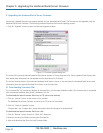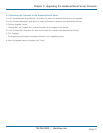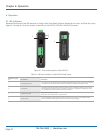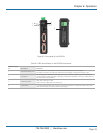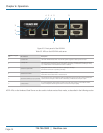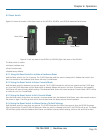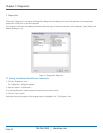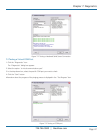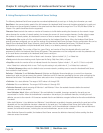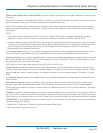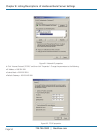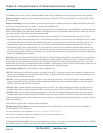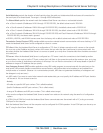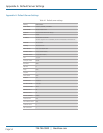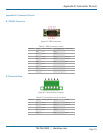
724-746-5500 | blackbox.com
Page 48
724-746-5500 | blackbox.com
Chapter 8: Listing/Descriptions of Hardened Serial Server Settings
8. Listing/Descriptions of Hardened Serial Server Settings
The following Hardened Serial Server properties are ordered alphabetically to assist you in finding the information you need.
Baud Rate is the communication speed of the link between the Hardened Serial Server and the device attached to its serial port.
Both devices must be configured to operate at the same baud rate. Baud rate values range from 75 to 230,400 Baud. (Refer to
Chapter 1 for specific baud rates that are supported.)
Character Count controls the maximum number of characters to buffer before sending the characters to the network. Larger
values decrease the number of network packets, but increase the amount of time to receive characters. Smaller values increase
the number of network packets, but decrease the amount of time to receive characters. The range is 1 through 65535.
Configuration files contain all of the configuration settings for the Hardened Serial Server. When the Hardened Serial Server
settings have been configured, you can save the settings using Hardened Serial Server Software. Existing configuration files can be
Opened (from Hardened Serial Server Software), which loads them into the Hardened Serial Server. This allows the same
configuration to be applied to multiple Hardened Serial Servers, or to reload a previously used configuration.
Data/Parity/Stop Bits. The number of Data bits, type of Parity, and number of Stop bits selected define the serial port
parameters at which the Hardened Serial Server will operate. These parameters must be configured to match the parameters set
on the serial device connected to the Hardened Serial Server's serial port.
• Data Bits controls the number of bits of data in each character. Options include 5, 6, 7, or 8 data bits.
• Parity controls the error-checking mode. Options are No Parity, Odd, Even, Mark, or Space.
• Stop Bits controls the number of bits to indicate the end of a character. Options include 1, 1.5, and 2. (1.5 bits is only valid
when 5 data bits is selected, which is rare. The 2 stop bits setting is only valid when 6, 7, or 8 data bits is selected.)
The Default Gateway address sets the default route to remote networks, enabling users to access the Hardened Serial Server
from outside the local network.
Delimiter 1, Delimiter 2, and Delimiter Removal. Delimiters and Delimiter Removal enable you to control how characters
received on a serial port are sent across the network. Delimiters are ASCII characters specified by the user when configuring the
Hardened Serial Server. The Hardened Serial Server takes action when it recognizes the specified character(s) on its serial port.
• Delimiter 1 is a start delimiter. The range of ASCII values is 0 through 255.
• Delimiter 2 is an end delimiter. The range of ASCII values is 0 through 255.
• Delimiter Removal controls removing of Delimiter 1 and Delimiter 2 from the received characters before the received
characters are sent to the network.
How Delimiters Work. When only Delimiter 2 (the end delimiter) is enabled, characters received by the serial port are
accumulated in a buffer. When the end delimiter is received on the serial port, the buffered characters, including the end
delimiter, are sent to the network. All characters received after the end delimiter are again buffered until another end delimiter
is received.
When both Delimiter 1 (start delimiter) and Delimiter 2 (end delimiter) are enabled, characters received by the serial port will be
discarded until the start delimiter character is detected on the serial port. The Hardened Serial Server then buffers the start
delimiter character and all subsequent characters received after it until the end delimiter is detected. When the end delimiter is
received, the buffered characters, including the start and end delimiters, are sent to the network.
When Delimiter Removal is enabled, the Hardened Serial Server removes the delimiter character(s) before sending the other
characters across the network.



